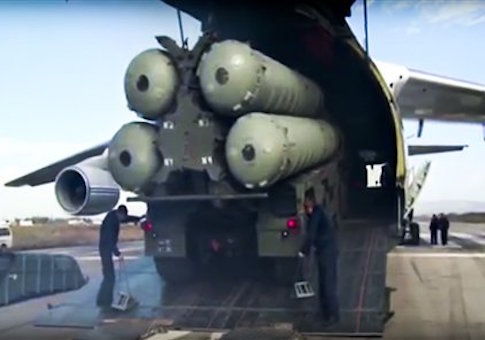Russia’s S-400 missile system in Syria has the range to target airbases in the region with a U.S. presence, according to a new analysis.
Moscow deployed the S-400, an advanced air defense system with surface-to-air missiles, at the end of last month after Turkey shot down a Russian jet that violated the airspace of the NATO country. The system was reported to be installed in the coastal Latakia Province at Bassel al-Assad International Airport, which also serves as a base for Russian and Syrian regime forces.
According to the Institute for the Study of War, Russia’s S-400 system has a range of up to 250 miles and the capability to track and target aircraft at multiple bases in the region. The think tank noted on Monday that two of those bases have a U.S. presence: Incirlik Airbase in Turkey, and the Al-Shaheed Muwaffaq Salti Airbase in Jordan.
"The S-400 SAM system is capable of contesting most of the airspace over Syria, southern Turkey, northern Jordan, a significant portion of Israel, as well as all of Lebanon and Cyprus," the institute said.
"At 250 miles, the S-400 is able to track and target aircraft based at numerous United States and Allied Coalition airbases (including Incirlik Airbase) in the region," it added.
U.S. defense officials have raised concerns about the potential threat of the Russian missile system to U.S. pilots, who continue to launch airstrikes against ISIS, also known as ISIL, in Syria and Iraq. Navy Capt. Jeff Davis, the Pentagon spokesman, said earlier this month that Moscow deployed "a capability that we don’t see as being productive in the fight against ISIL."
"Whether it’s putting air-to-air missiles on planes or putting in surface-to-air missiles, those are things that are clearly not about ISIL, as ISIL doesn’t have any aircraft," Davis said. "So far it has not had any impact on our operations [over Syria], but it's certainly something we're aware of, particularly with the surface-to-air missiles."
A Pentagon spokesman did not respond to a request for comment about the institute’s new analysis.
Russia continues to be widely condemned for its airstrikes in Syria, which appear to be targeting Syrian rebel groups—including some backed by the United States—in an attempt to prop up Syrian dictator Bashar al-Assad. Russian bombers rarely strike ISIS positions in Syria.
"Russian warplanes concentrated airstrikes against rebel positions southwest of Aleppo City from December 18 to December 21, enabling pro-regime forces to seize the key town of Khan Touman and several nearby villages on December 20," the institute said in a separate analysis. "Russian airstrikes later shifted to target rebel forces along the strategic M5 Highway to Aleppo City in likely preparation for future offensive operations."
"Russia conducted only a limited number of airstrikes against ISIS targets in Aleppo and Homs Provinces over the reporting period," it added.
Humanitarian groups have accused Russia of killing hundreds of civilians and deliberately striking civilian infrastructure in rebel-held parts of northern Syria, including border crossings used by aid workers, grain silos, bakeries, and hospitals.
Additionally, the institute noted reports that Moscow has used PFM-1 "Green Parrot" cluster mines in Syria. The mines, which are coated in bright colors and can be mistaken for toys by children, were responsible for child casualties during the Soviet war in Afghanistan.
